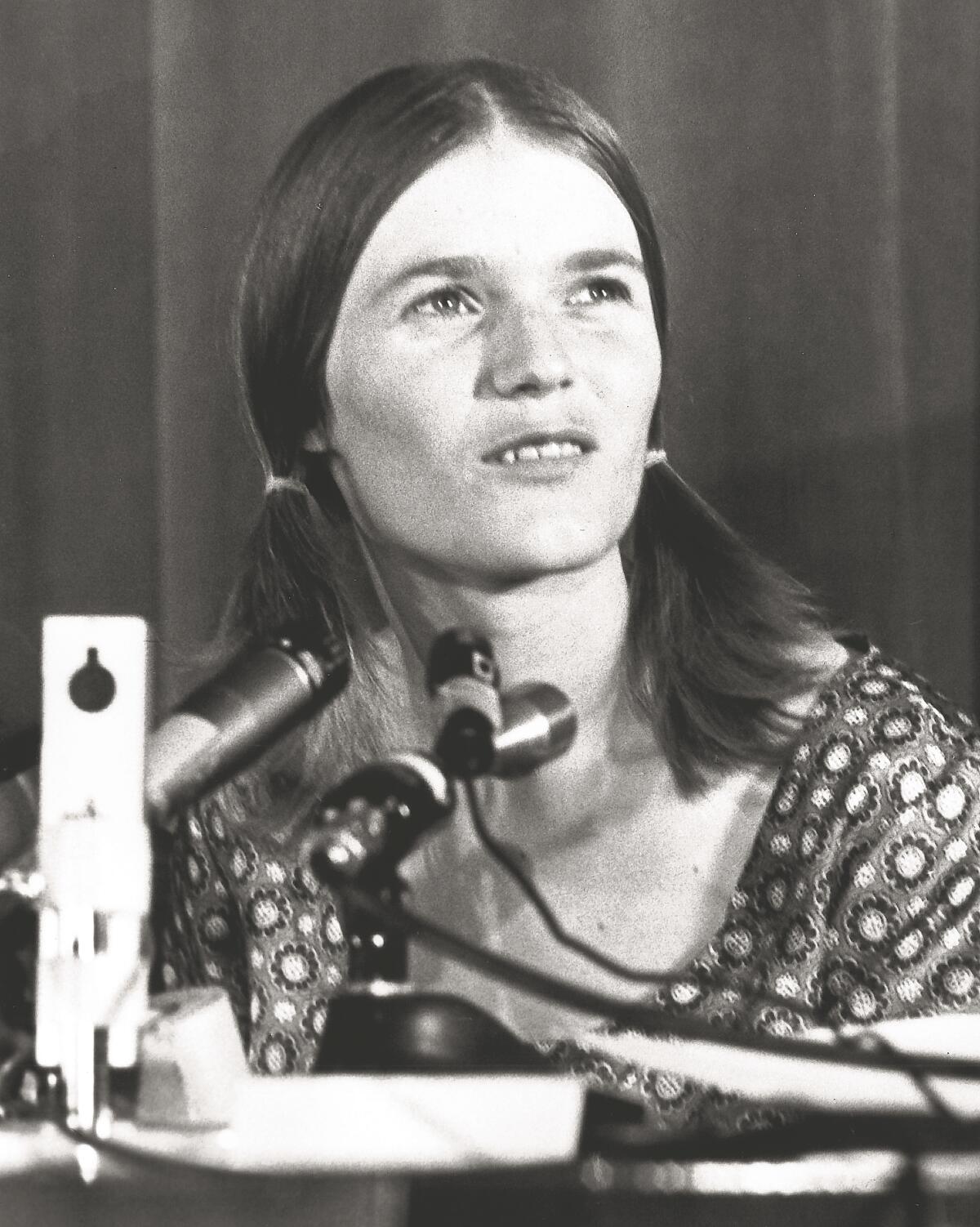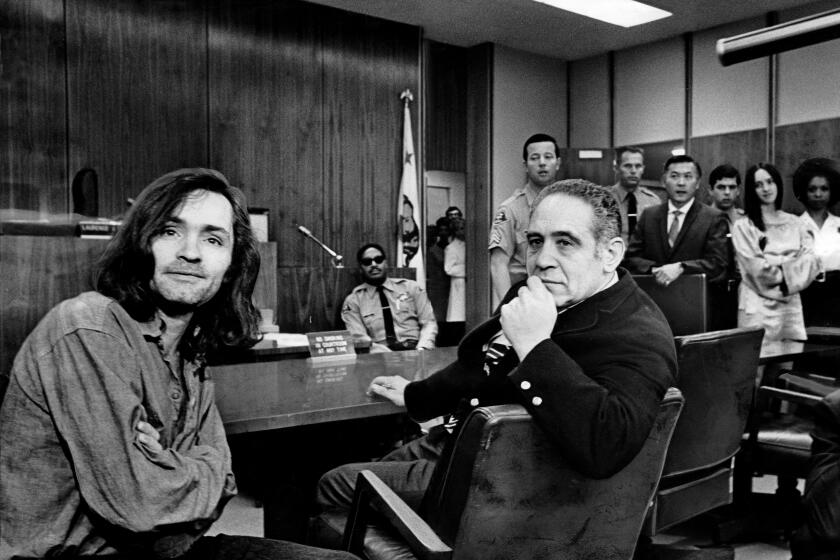Linda Kasabian, Charles Manson follower who helped send him to prison, dies at 73

- Share via
In 1969, 20-year-old Linda Kasabian came to California to find God. Instead, she found Charles Manson.
Just weeks after joining his ragtag “family” of lost and damaged souls, Kasabian was entwined in the brutal bloodbath that became known around the world as the Tate-LaBianca murders. Actress Sharon Tate and six others were killed under orders from Manson during a two-night rampage that would terrify Los Angeles and bring the 1960s to an abrupt and grisly end.
Kasabian, who went on to serve as the chief prosecution witness in the sensational 1970 trial that sent Manson and three followers to prison for life, died Jan. 21 at a hospital in Tacoma, Wash., the Washington Post reported. The Times obtained a copy of her death certificate, which identified her as Linda Chiochios, one of various names she used after the Manson trials. No cause was listed. She was 73.
Like many of the era’s youthful seekers, Kasabian drifted around the country taking drugs, living in communes and practicing free love. In the summer of 1969, she went to Los Angeles to reconcile with her husband, Bob Kasabian, who was staying at a friend’s trailer in Topanga Canyon, but he wound up leaving her.
Stranded with her 1-year-old daughter, Tanya, and pregnant with her second child, she was excited when a new acquaintance, Catherine “Gypsy” Share, invited her to Spahn Ranch, a sprawling, remote property in the San Fernando Valley where “this beautiful man named Charlie” had established a commune. She jumped at the chance to join it.
“I was like a little blind girl in the forest,” Kasabian said in her testimony at the 1970 trial, “and I took the first path that came to me.”
That path quickly led to mayhem.
On her first night at the ranch, she slept with Charles “Tex” Watson, a high-ranking member of the Manson clan. He talked Kasabian into stealing $5,000 from her husband’s friend in Topanga, justifying the crime by telling her “that she could do no wrong and that everything should be shared,” Vincent Bugliosi, the L.A. County deputy district attorney who led the prosecution of the Manson killers, wrote in his bestselling book about the case, “Helter Skelter.”
Kasabian returned to Topanga the next day and absconded with the money, which she turned over to the clan along with most of her belongings.
She went on to have sex with the other men in the commune, but it was Manson whom she fell in love with. She was in thrall to the scrawny , scraggly-haired ex-con, who threw LSD orgies, was paranoid about Black people and warned of a coming race war that he called “Helter Skelter.” Kasabian testified that she believed he was the Messiah and learned to obey him.
“The girls,” she said, referring to Manson’s other women, “used to tell me never to question Charlie. That what Charlie said was right.”
So she acquiesced to his child-rearing philosophy that gave children “complete freedom” from their parents. “They wanted me to stay away from Tanya. They were killing her ego,” she testified. She said she only dared to care for and feed her daughter when Manson was not around.
She also participated in his “creepy-crawly” raids, which entailed breaking into mansions in Beverly Hills and Bel-Air while the residents were asleep, then rearranging and pilfering their possessions.
Charles Manson and his “family” committed heinous crimes across Los Angeles in 1969. Here is a timeline of what led up to the murders and the aftermath.
When Manson summoned Kasabian on the afternoon of Aug. 8, 1969, she thought he wanted to send her on another nighttime thieving mission. This time, however, he instructed her to grab a knife, a change of clothes and her driver’s license. “Go with Tex, and do whatever Tex tells you to do,” he said, according to Bugliosi’s account.
For the record:
4:24 p.m. March 1, 2023A previous version of this article referred to Charles “Tex” Watson as “Watkins” in three instances.
She drove with Watson, Susan Atkins and Patricia Krenwinkel to the secluded Benedict Canyon estate where Tate lived with her husband, director Roman Polanski, who was out of the country filming. Once the Manson crew arrived on Cielo Drive, the nightmare began.
Kasabian testified that she saw Watson shoot into a car that was coming down the driveway and kill the driver, Steven Parent, 18, a friend of the property’s caretaker. She remained outside as the lookout while the others entered the house and within a few minutes heard the “horrifying sounds” of Tate and her house guests pleading for their lives.
When Atkins, who went by the nickname Sadie, emerged from the house, Kasabian begged her to stop the bloodshed. “I just looked at her and I said, ‘Sadie, please make it stop.’ And she said, ‘I can’t, it’s too late,’” she recounted in a 2009 interview with radio host Larry King.
She saw Watson chase a bleeding man — Polanski friend Voytek Frykowski, 32 — into the bushes and knife him repeatedly. She saw Krenwinkel with an upraised knife pursue a woman in a white gown — Frykowski’s girlfriend, Abigail Folger, 25 — across the lawn.
Inside, stabbed and hanged, was Tate, 26, who was eight months pregnant. The fifth victim was Hollywood hairstylist Jay Sebring, 35.
Kasabian went back to the car and waited. “My thoughts went to going to get help. I didn’t do it because I was afraid they would kill me and they would kill my daughter,” she said in the 2009 History Channel documentary “Manson.”
The next night, Manson joined the deadly foray to the Los Feliz home of grocer Leno LaBianca, 42, and his wife, Rosemary, 38. Manson tied up the couple, then ordered Watson, Atkins, Krenwinkel and a fourth clan member, Leslie Van Houten, into the house. They stabbed the LaBiancas, then used the couple’s blood to scrawl the phrases “Death to Pigs” and “Rise” on the walls. While the slaughter unfolded, Manson returned to the car where Kasabian was waiting.
After leaving the LaBianca house, Manson ordered Kasabian and another follower, Steven “Clem” Grogan, to kill an actor friend who lived in Venice, but Kasabian thwarted the plan by deliberately knocking on the wrong door. “I just wasn’t going to kill somebody. If Charlie wanted to kill me, then he was going to kill me,” she said in the “Manson” film.
Two days later, Manson told Kasabian to visit Bobby Beausoleil, the clan member who had been arrested a few days earlier for killing Manson associate Gary Hinman at Manson’s direction. She seized the opportunity to escape, leaving her daughter Tanya behind because the child had been taken to a remote location with other Manson family children. She returned for her a few months later, after the ranch was raided and Tanya was placed in foster care.
Kasabian hitchhiked across the country, ending up at her mother’s home in New Hampshire. When she learned she was wanted on a fugitive warrant, she surrendered to local authorities.
In Los Angeles, she was charged with seven counts of murder but was given immunity from prosecution after she testified against Manson and the others.
Born Linda Drouin in Maine on June 21, 1949, she grew up in Milford, N.H., in an unstable home and left when she was 16. After dropping out of high school, she married, divorced and married again, and drifted from commune to commune, practicing free love and dropping acid. She became a mother at 19.
“She described all this with a candor that at times shocked me,” Bugliosi wrote, “yet which, I knew, would be a plus on the witness stand. ... I knew that if Linda testified truthfully about those two nights of murder, it would be immaterial whether she had been promiscuous, taken dope, stolen.”
During her 18 days on the witness stand, she held firm against attacks by the defense team and Manson, whose attempts at intimidation included making throat-slashing gestures at her.
The colorful defense attorney also represented ‘Onion Field’ killer Jimmy Lee Smith.
Although the jury foreman discounted the importance of Kasabian’s testimony after guilty verdicts were handed down for Manson, Krenwinkel, Atkins and Van Houten, Bugliosi had a different view. “I doubt we would have convicted Manson without her,” he told the Observer in 2009.
She also was a prosecution witness at Watson’s trial. Like the others, he was convicted and sentenced to death, which changed to life in prison after the California Supreme Court briefly ruled the death penalty unconstitutional in 1972. Atkins and Manson died behind bars, in 2009 and 2017, respectively.
After the trials, Kasabian went into hiding and changed her name but could not completely elude public notice.
She is often mentioned in connection with writer Joan Didion’s classic 1979 essay “The White Album,” in which Didion tells of buying a dress for Kasabian to wear on her first day on the stand. Two decades later, a British rock band, inspired by the former Manson follower’s notoriety, named itself after her. And the 2019 Quentin Tarantino movie “Once Upon a Time ... in Hollywood,” which takes place the year of the murders, includes a character based on Kasabian called Flower Child.
Kasabian lived in New Hampshire and later in Washington state, where she had run-ins with the law for drug possession. She raised four children, including a son who was born while she was in prison awaiting the start of the Manson trial.
She said she thought about the murders every day.
“I could never accept the fact that I was not punished for my involvement in this tragedy,” she said in the 2009 film. “I felt then what I feel now, always and forever, that it was a waste of life that had no reason, no rhyme. It was wrong. And it hurt a lot of people.”
Woo is a former Times staff writer.
More to Read
Sign up for Essential California
The most important California stories and recommendations in your inbox every morning.
You may occasionally receive promotional content from the Los Angeles Times.













